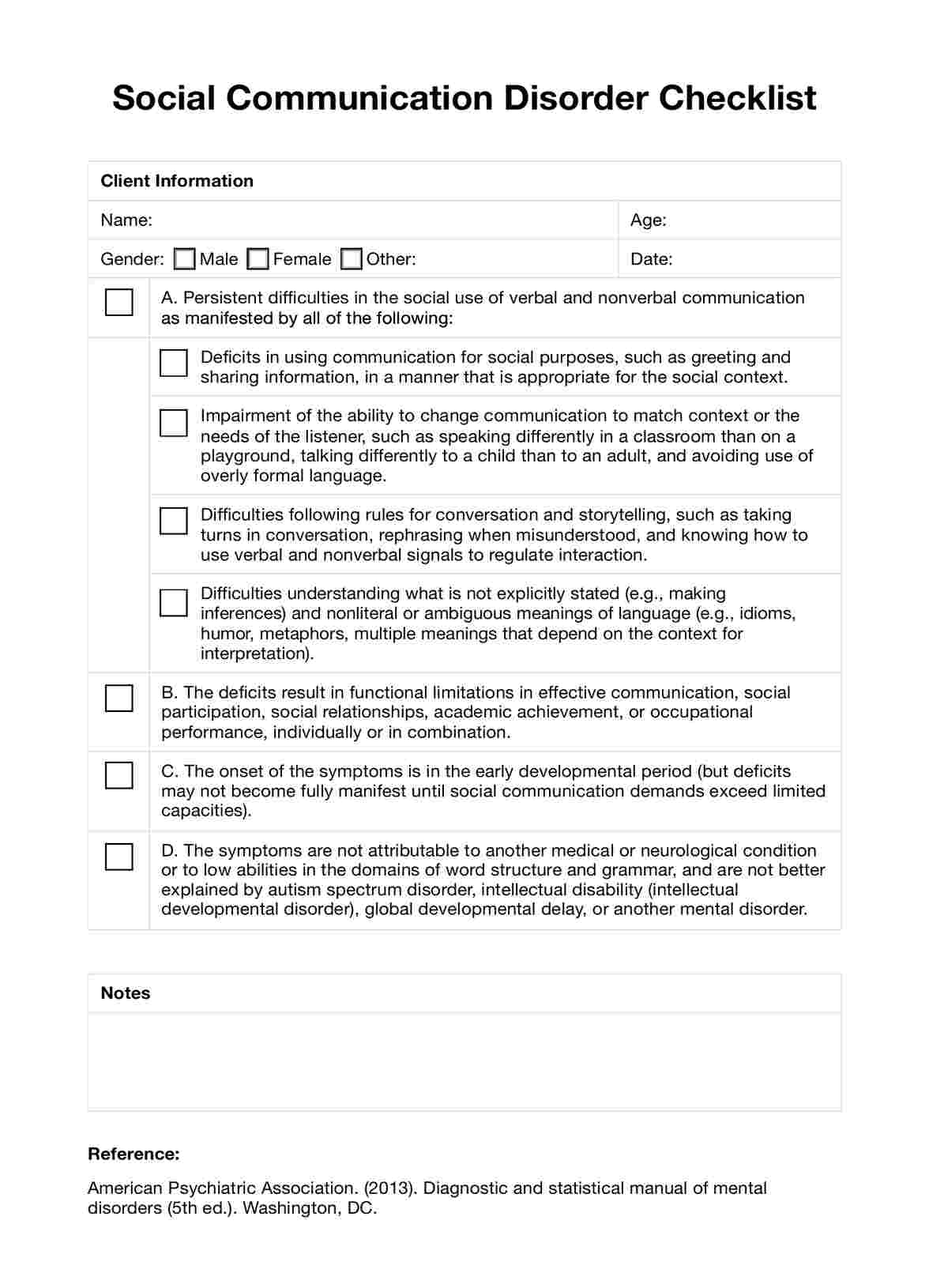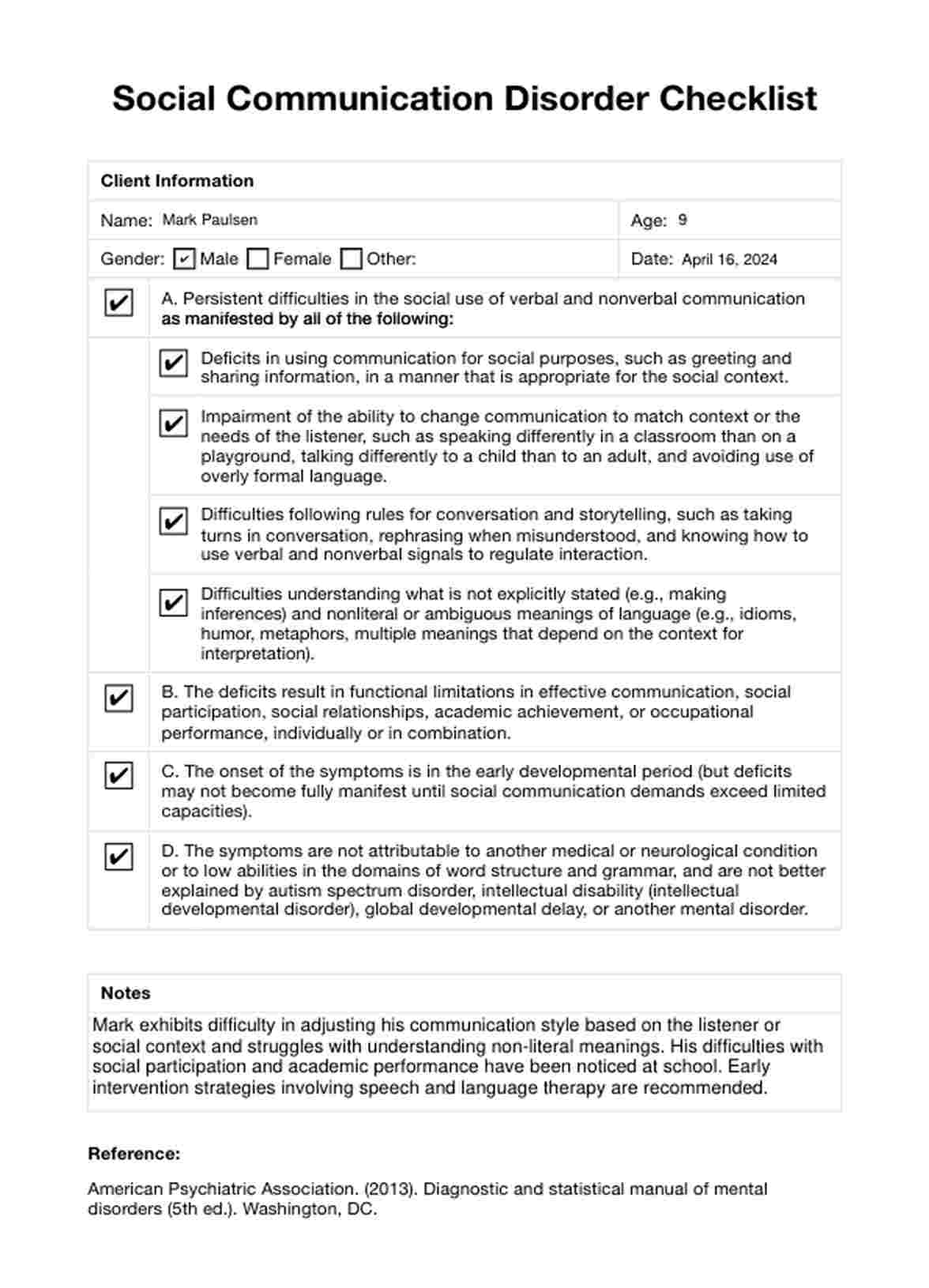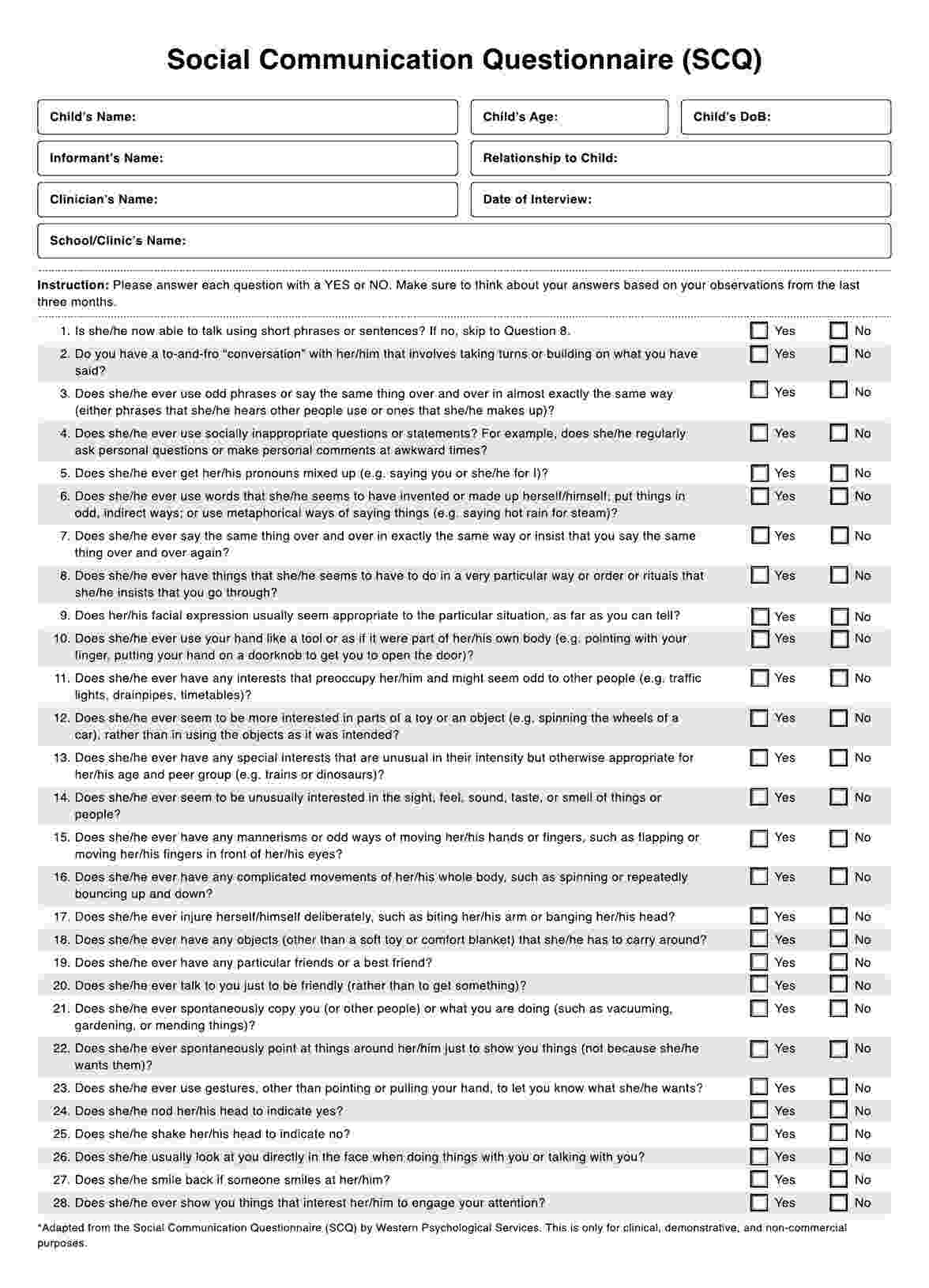Social Communication Disorder Checklist PDF
Access a guided checklist to aid in diagnosing social communication disorder for earlier detection and intervention.


What is social communication disorder?
Social communication disorder (SCD) is a neurodevelopmental disorder characterized by persistent difficulties using verbal and nonverbal communication for social purposes. It is a relatively new diagnostic category introduced in the DSM-5 (American Psychiatric Association, 2013). SCD affects social communication skills, which also influences functioning and development.
This pragmatic language impairment can lead to difficulties establishing and maintaining relationships, participating in conversations, understanding humor or sarcasm, and engaging in age-appropriate social interactions (Norbury, 2013). This complication can affect social and emotional development, especially among growing children.
It is important to note that SCD is not associated with intellectual disabilities, language disorders, or other neurodevelopmental conditions like autism spectrum disorder. The deficits in social communication are the primary area of concern.
Characteristics of social communication disorder
Social communication disorder (SCD) is characterized by a range of difficulties in using verbal and nonverbal communication for social purposes. Some key characteristics of SCD include:
- Trouble understanding and following social rules and norms, such as taking turns in conversations, maintaining appropriate personal space, or using appropriate greetings.
- Difficulty interpreting nonliteral language, such as idioms, metaphors, sarcasm, or humor. They may take things too literally and struggle to grasp implied meanings.
- Challenges in integrating verbal and nonverbal signals during social interactions. For example, they may miss the nuances of facial expressions, tone of voice, or body language.
- Inability to adapt communication style to different social contexts or audiences. They may use language that is too formal or informal for the situation.
- Difficulties understanding and expressing emotions appropriately, both their own and others.
- Struggles with maintaining eye contact, initiating or responding to social interactions, and taking an interest in others' thoughts and feelings.
- Challenges understanding complex or abstract language, such as proverbs, analogies, or figurative speech.
While individuals with SCD may have challenges in areas involving communication skills, their intelligence and language skills (such as vocabulary, grammar, and pronunciation) are typically within normal limits.
It's also important to note that the severity and specific manifestation of these characteristics can vary from person to person.
Causes and risk factors of this disorder
Multiple factors contribute to SCD, and an interplay between genetic, neurobiological, and environmental elements shapes its onset and progression.
- Genetic factors: A genetic component is suggested to be associated with SCD, with the disorder observed to run in families. This familial pattern indicates a hereditary aspect, although the specific genes involved are yet to be fully understood.
- Neurobiological factors: Brain imaging techniques have identified variations in the brain structure and connectivity that correlate with social communication challenges. These neurobiological insights are crucial for understanding the underlying mechanics of SCD and potentially guiding the development of targeted interventions.
- Environmental factors: Adverse conditions such as social deprivation, limited exposure to language-rich environments, or negative social interactions can contribute to social communication difficulties. These factors emphasize the importance of nurturing environments in the early stages of development.
- Co-occurring Conditions: SCD frequently co-occurs with other developmental disorders, such as attention-deficit/hyperactivity disorder, learning disabilities, and speech sound disorders.
Social Communication Disorder Checklist PDF Template
Social Communication Disorder Checklist PDF Example
How do we diagnose social communication disorder?
Diagnosing social communication disorders involves carefully examining an individual's communication habits in various situations. The focus is on identifying a consistent pattern of challenges in using communication and social language skills for social interactions. The diagnostic process commonly involves the following steps:
Thorough history taking
Gathering a comprehensive history forms the bedrock of SCD diagnosis. This includes obtaining details about the individual's developmental milestones, family history, and schooling environment. Structured parent questionnaires can also provide valuable insights into the person's communication habits across different settings.
Observational assessment
Direct observation of the individual’s communication in naturalistic settings, like home or school, can provide rich data. This could involve observing how the individual uses both verbal and non-verbal communication modes to engage with peers and adults.
Standardized testing
Standardized tests play an instrumental role in diagnosing SCD. Social communication assessment tests explore aspects such as the ability to adapt speech according to the social context, maintain a conversation, and interact using appropriate gestures and expressive language.
Multidisciplinary evaluation
A team-based approach is essential for diagnosing SCD. Collaboration with educators, psychologists, or speech and language pathologists can help capture a holistic picture of the individual's communication skills in various contexts.
It's essential to differentiate SCD from other communication disorders and to ensure the communication challenges are not due to a more generalized cognitive or language impairment. A thorough diagnostic process will enable a better understanding of social communication deficits, leading to effective and individualized intervention.
What is a Social Communication Disorder Checklist?
Our Social Communication Disorder Checklist is a tool guided by the Diagnostic and Statistical Manual of Mental Disorders, Fifth Edition (DSM-5). It assists in screening and exploring the symptoms associated with this disorder. This tool can be helpful for speech-language pathologists, speech therapists, and classroom teachers in early detection and intervention, especially for school-age children.
How does our checklist template work?
Our Social Communication Disorder (SCD) Checklist Template is designed to simplify the diagnostic process, providing a clear framework for assessing individuals who may exhibit symptoms of SCD. Here is a step-by-step guide on how to effectively use this checklist:
Step 1: Gather initial information
Before starting with the checklist, collect basic information about the individual, including age, educational or occupational setting, and any prior assessments or diagnoses.
Step 2: Observe and note
The heart of this checklist involves observing the individual in various social and communicative contexts. Note specific instances that exemplify the diagnostic criteria for SCD, as outlined in the DSM-5. This could include observing the individual's interactions with peers and family members during structured activities.
Step 3: Conduct structured interviews
Incorporate structured interviews with parents, teachers, and other relevant individuals who have insights into the individual's social communication capabilities across different settings. These interviews can provide essential perspectives on the individual's communication skills and social adaptation.
Step 4: Complete the checklist
With observations and interview data in hand, systematically go through the checklist, marking symptoms and behaviors that align with the SCD criteria from the DSM-5. The checklist is designed to ensure a comprehensive assessment, capturing difficulties in using communication for social purposes and other aspects of language processing and pragmatic skills.
Step 5: Review and plan next steps
Once the checklist is completed, review the documentation of symptoms against the diagnostic criteria for SCD. If the individual's behaviors substantially align with the criteria, this might indicate the presence of SCD. Based on the findings, plan to discuss the results with a multidisciplinary team or relevant specialists to determine the best course of action, including potential interventions or supports.
Benefits of using this checklist
The Social Communication Disorder (SCD) Checklist is essential for evaluating and potentially diagnosing SCD. Its structured approach offers several advantages for practitioners who want to recognize and address the disorder:
Tailored observation
The checklist encourages thorough observation of social interactions across various environments. This focus ensures that symptoms are not simply anecdotal but are evidenced in a range of situations, providing a reliable basis for diagnosis.
Streamlined communication
Using the checklist as a common reference point facilitates clearer communication among multidisciplinary teams. Sharing concrete observations based on the checklist can expedite collaborative decision-making regarding diagnosis and intervention strategies.
Accurate diagnosis
As the checklist follows the DSM-5 criteria, this helps in distinguishing SCD from other disorders with overlapping symptoms, such as autism spectrum disorder. This precision is crucial for developing effective, targeted intervention plans.
Effective monitoring and follow-up
With a completed checklist, tracking progress becomes more manageable. It acts as a baseline for assessing the impact of interventions over time, allowing adjustments to be made as necessary.
How is social communication disorder treated and managed?
Social communication disorder (SCD) is typically treated and managed through a combination of interventions tailored to the individual's specific needs and challenges. Here are some common approaches:
Speech therapy
Speech and language therapy may focus on teaching strategies for understanding and using nonliteral language, following conversational rules, interpreting social cues, and improving pragmatic language skills. This can also help guide clients to adjust speech style based on a particular setting or context.
Language processing interventions
Individuals with SCD may benefit from exercises and activities that improve their ability to comprehend and process language, particularly in social contexts. These activities can involve working on skills such as making inferences, understanding implied meanings, receptive language, and interpreting nonverbal cues.
Augmentative and alternative communication (AAC)
For some individuals with SCD, AAC devices or systems may be helpful in supporting their communication needs. These tools can range from low-tech options like picture boards to high-tech speech-generating devices, facilitating communication beyond speech alone.
Social skills training
This type of intervention focuses on teaching specific social skills necessary for effective communication and interaction. It may involve peer-implemented interventions such as role-playing, modeling, and practicing conversation skills such as taking turns, understanding social norms, and interpreting facial expressions and body language.
References
American Psychiatric Association. (2013). Diagnostic and statistical manual of mental disorders (5th ed.). https://doi.org/10.1176/appi.books.9780890425596
Norbury C. F. (2013). Sources of variation in developmental language disorders: evidence from eye-tracking studies of sentence production. Philosophical transactions of the Royal Society of London. Series B, Biological sciences, 369(1634), 20120393. https://doi.org/10.1098/rstb.2012.0393
Commonly asked questions
While both SCD and ASD involve challenges with social communication, ASD also includes repetitive behaviors and restricted interests, which are not characteristics of SCD.
Parents can help by engaging in interactive play, reading, and activities stimulating conversation and social interaction. Consistency, positive reinforcement, and collaboration with educators and therapists are crucial.
With appropriate intervention, individuals with SCD can significantly improve their communication skills. Early detection and tailored therapy are vital to maximizing progress and outcomes.






















-template.jpg)






















































































